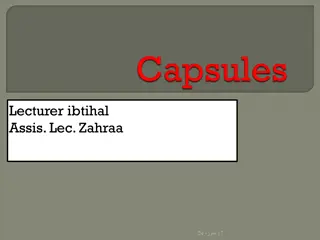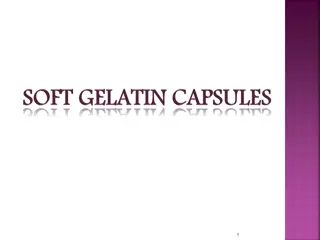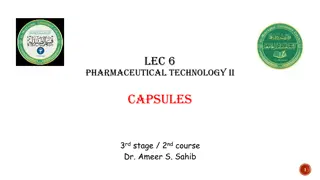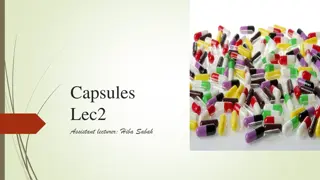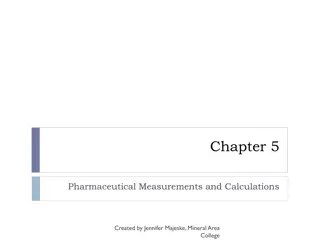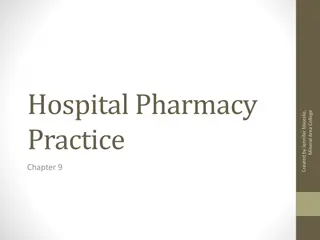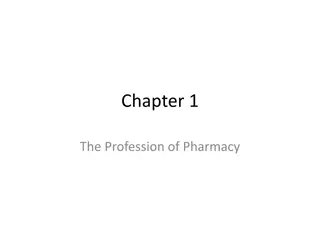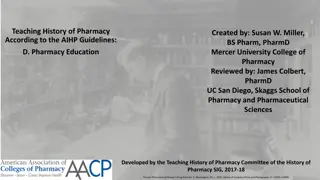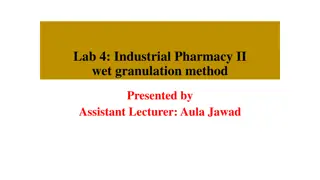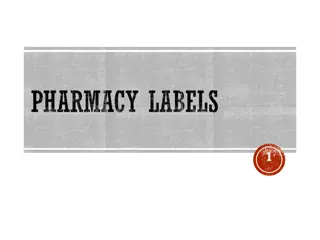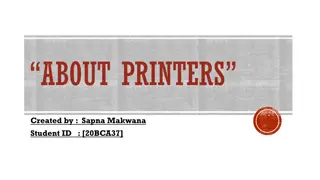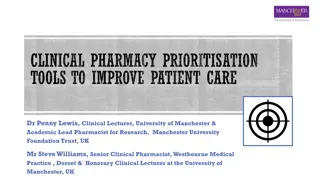Understanding Capsules in Pharmacy: Types, Advantages, and Disadvantages
Capsules in pharmaceuticals are solid unit dosage forms encasing precise amounts of medicines in gelatin shells. They come as hard or soft gelatin capsules, offering benefits like easy swallowing, taste masking, rapid release of medication, and cost-effectiveness. However, capsules have limitations with liquids, hygroscopic ingredients, and efflorescent substances. Various shapes and sizes of capsules cater to different needs in the field of pharmaceutics.
Download Presentation

Please find below an Image/Link to download the presentation.
The content on the website is provided AS IS for your information and personal use only. It may not be sold, licensed, or shared on other websites without obtaining consent from the author. Download presentation by click this link. If you encounter any issues during the download, it is possible that the publisher has removed the file from their server.
E N D
Presentation Transcript
1 9/13/2024 Department of Pharmaceutics
INTRODUCTION: CAPSULES: The term capsule is derived from the Latin word capsula, meaning a small container. Capsules are defined as solid unit dosage forms enclosing accurately measured quantity of medicaments in a water soluble shell made up of gelatin. Depending on the composition of gelatin, capsules are available in two types-hard gelatin capsules which are intended for the capsulation of particulate solids ( such as powders, granules, and pellets) and soft gelatin capsules which encloses the medicaments in the form of powders, pastes, or non-aqueous liquids. 9/13/2024 Department of Pharmaceutics 2
ADVANTAGES OF CAPSULES: Capsules are easy to swallow because of their slippery texture. They efficiently mask the unpleasant taste of certain drugs which cannot be achieved in case of tablets or liquid oral formulations. There are attractive in appearance. They can be filled quickly and conveniently. They are economical. They are easy to handle and carry. 3 . 9/13/2024 Department of Pharmaceutics
The ready solubility of gelatin at gastric pH provides rapid release of medication in the stomach. Packaged and shipped by manufacturers at lower cost less breakage than liquid forms 4 9/13/2024 Department of Pharmaceutics
DISADVANTAGES OF CAPSULES: Capsules are not suitable for liquids that dissolve gelatin, such as aqueous or hydro alcoholic solutions. The concentrated solutions which require previous dilution are unsuitable for capsules because if administered as such lead to irritation into stomach. Capsules are not suitable for enclosing highly acidic or alkaline drugs because acidic drugs cause hydrolysis of gelatin, whereas alkaline drugs cause tanning effect which reduces the solubility of the gelatin shell 9/13/2024 Department of Pharmaceutics 5
Hygroscopic ingredients cannot be capsulated as they absorb water from the shell and make it brittle. Efflorescent substances cannot be capsulated as they make the shell moist by releasing moisture. 6 9/13/2024 Department of Pharmaceutics
SHAPES OF CAPSULE: *The largest size of the capsule is No: 000. *The smallest size is No: 5. *The standard shape of capsules is traditional, symmetrical bullet shape. 7 5 9/13/2024 Department of Pharmaceutics
Formulation of hard gelatin capsule shell: Gelatin, water, colorants, opacifying agents, Preservatives: Flavours, Sugars Solvents Thickening agents 8 9/13/2024 Department of Pharmaceutics
GELATIN: Gelatin is a heterogeneous protein obtained by irreversible hydrolysis of animal collagen processed from bones, white connective tissue, skin trimmings and frozen pork skin. Gelatin is a regarded as the best suitable ingredient for the manufacture of capsule shell owning to its unique physical, chemical and physiological properties. 9 9 9/13/2024 Department of Pharmaceutics
These properties depend on the collagen source, methods of extraction, ph value, thermal degradation and electrolyte content. commercially it is available as fine or coarse powder, flakes and sheets. It has unique solubility characteristics, being soluble in hot water and in warm gastric fluids but insoluble in cold water. However it softens upon absorbing 10 times its weight of water, a property which facilitates the disintegration of capsules in the stomach upon ingestion. 10 9/13/2024 Department of Pharmaceutics
TYPES OF GELATIN: There are two basic types of gelatin 1. Type -A 2. Type - B 3.TYPE - A It is obtained by acid hydrolysis of pork skin and exhibits an iso electric point at pH-9. type A gelatin contributes plasticity and clarity to the gelatin blend therefore reduces the cloudiness in the finished capsules. 11 9/13/2024 Department of Pharmaceutics
2.TYPE - B This grade of gelatin is obtained by acid and alkaline treatment of animal bones and hide portions. exhibits an iso electric point at pH-4.7. 12 9/13/2024 Department of Pharmaceutics
13 9/13/2024 Department of Pharmaceutics
PROPERTIES OF GELATIN: 1 Bloom strength: physical stability and strength of the capsule shell is directly proportional to the bloom strength . Bloom strength is defined as the measure of cohesive strength of cross linking b/w the gelatin molecules. Bloom strength is determined by measuring the weight in grams required to penetrate a plastic plunger of 0.5 inches in diameter 4 mm deep into 6.66% w/w gelatin gel maintained at 10 degree centigrade. 13 14 9/13/2024 Department of Pharmaceutics
Bloom strength Bloom strength ranges from 150-250 gms. 15 9/13/2024 Department of Pharmaceutics
3. Viscosity; In general the higher the bloom, the greater the viscosity. Viscosity is determined by measuring the flow time of a 6.67% solution of gelatin viscometer at 60 C. Viscosity measurement is given in millipoise units and varies between 25 and 40mps. through a U-tube 14 16 9/13/2024 Department of Pharmaceutics
4. Foamability; In general pigskin grades tend to have better foaming properties. Gelatin lowers the surface tension, allowing for the incorporation and stabilizes the aerated. of foam air, once 17 9/13/2024 Department of Pharmaceutics
Color and odor; The gelatin should be as clear as possible in solution. Clarity is measured using a turbidimeter . The gelatin should be without odor. 15 18 9/13/2024 Department of Pharmaceutics
Plasticizers: these are added to the gelatin mass to confer softness, hardness, elasticity and thickness to the capsule shell. The amount of plasticizer to be added depends upon the type of capsule (hard or soft) and storage conditions. Eg: glycerin, sorbitol, propylene glycol 19 9/13/2024 Department of Pharmaceutics
Water : Water is essential component in preparation in gelatin mass. Similar to the plasticizer , the amount of water to be added depends on the type of capsule and storage conditions. Soft gelatin capsule shells contain more water and plasticizer than hard gelatin capsule. 20 9/13/2024 Department of Pharmaceutics
Colorants: Capsule shells may be clear and colourless, but to improve their elegance and to make them distinctive and consumer appealing, certain FD&C and D&C approved dyes, pigments are added to the gelatin mass. 21 9/13/2024 Department of Pharmaceutics
Opacifying agents: These are used to minimize the transparency and to make the capsule shell opaque. Opacified capsule shells prevent the degradation of photosensitive fill materials. Eg: titanium dioxide 22 9/13/2024 Department of Pharmaceutics
Presevatives: Since gelatin contains water, preservatives are added to retard the growth of microbes and to maintain the stability of the shells for a long period Eg: methyl paraben, propyl paraben. Flavours: these are added to impart good flavour to the capsule shell. Sugars: these are used in chewable gelatin capsules to impart sweet taste and to mask objectionable taste. 23 9/13/2024 Department of Pharmaceutics
Solvents: These are added to impart elegance and palatability to the capsule shells. Eg: oils Thickening agents: Since viscosity of the gelatin is an important aspect of the its quality therefore certain thickening agents are added to adjust the desired viscosity. Eg: methyl cellulose. 24 9/13/2024 Department of Pharmaceutics
FORMULATION OF HARD GELATIN CAPSULE FILL MATERIAL A. SLECTION OF INGREDIENTS: IN ADDITION TO THE ACTIVE INGREDIENTS, CAPSULE FORMULATION REQUIRE THE USE OF ADDITIONAL NON-ACTIVE INGREDIENTS CALLED EXCEPIENTS TO PRODUCE A CAPSULATED BLEND. IDEAL PROPERTIES OF ADDITIVES: THEY SHOULD NOT ALTER THE THERAPEUTIC ACTIVITY OF THE DRUG. THEY SHOULD NOT REACT WITH OTHER ADDITIVES OF THE PREPARATION. THEY SHOULD BE STABLE THROUGHT OUT THE SHELF LIFE OF THE PRODUCT. THEY SHOULD BE OF GOOD QUALITY AND SHOULD NOT IMPART ANY IMPURITIES TO THE DOSGEFORM. 25 9/13/2024 Department of Pharmaceutics
FORMULATION OF CAPSULE FILL MATERIAL DILUENTS: THESE ARE ALSO CALLED AS FILLERS. WHEN THE DOSE OF PARTICULAR DRUG SUBSTANCE IS TOO SMALL TO COMPLETELY FILL THE SMALLEST CAPSULE SHELL, DILUENTS ARE ADDED TO PRODUCE THE PROPER CAPSULE FILL VOLUME. EG: LACTOSE, MANNITOL, MCC, STARCH DISINTEGRANTS:THEY PROMOTE THE BREAKUP AND DISTRIBUTION OF THE CAPSULE CONTENTS IN THE STOMACH. HENCE HELP IN EVOKING FASTER THERAPEUTIC EFFECT. 26 9/13/2024 Department of Pharmaceutics
FORMULATION OF CAPSULE FILL MATERIAL GLIDANTS/ LUBRICANTS: THEY ENHANCE THE FLOW PROPERTIES OF THE CAPSULE FILL BY ALLOWING STEADY PASSAGE FROM THE HOPPER THROUGH THE AUTOMATED EUIPMENT INTO THE CAPSULE SHELLS. EG: CALCIUM STEARATE, MG.STEARATE, AND TALC ETC SURFACTANTS: THESE AGENTS FACILLITATES THE WETTING OF DRY PARTICLES BY THE GI FLUIDS BY MINIMIZING THE WATER PROOFING PROPERTIES OF CERTAIN WATER INSOLUBLE AGENTS FILLED IN THE CAPSULE. EG: SLS, 27 9/13/2024 Department of Pharmaceutics
ANTIDUSTING AGENTS: DUST IS CONSIDERED TO BE THE MAJOR PROBLEM IN LARGE SCALE CAPSULE FILLING OPERATIONS. DUST FROM POWDER MIX CONTAING POTENT DRUGS IF INHALED BY THE OPERATORS MAY LEAD TO SEVERE HEALTH COMPLICATIONS. TO PREVNT THIS SOME ANTIDUSTING AGENTS ARE MIXED. 28 9/13/2024 Department of Pharmaceutics
B. PRPEARATION OF FORMULATION: THERAPEUTICALLY ACTIVE CONSTITUENTS ARE THOROUGHLY MIXED WITH SUITABLE ADDITIVES. THE UNIFORM MIXTURE SO OBTAINED IS FILLED INTO THE CAPSULE SHELLS. DRUGS IN LOW DOSES ARE TO BE STRICTLY MONITORED WHILE BLENDING FOR UNIFORMITY, THE LACK OF WHICH MAY ALTER THE DRUG DISTRIBUTION THUS AFFECTING THE DESIRED THERAPEUTIC EFFICACY. FOR FILLING OF POWDERED DRUD IN THE CAPSULE SHELL THE DENSITY AND PARTICLE SIZE OF BOTH THE DRUG AND ADDITIVES SHOULD BE ALIKE FOR UNIFORM MIXING. 29 9/13/2024 Department of Pharmaceutics
PELLETS: DRUGS SUBTSNCES WHICH ARE DESIGNED FOR MODIFIED RELEASE ARE MADE INTO PELLETS AND COATED WITH SUITABLE COATING AGENTS. THESE COATED PELLETS ARE THEN FILLED IN THE EMPTY CAPSULE SHELL. 30 9/13/2024 Department of Pharmaceutics
TYPES OF CAPSULES: Capsules are available in two types: 1.Hard gelatin capsules 2.Soft gelatin capsules. 1.Hard gelatin capsule 2.Soft gelatin capsule 31 9/13/2024 Department of Pharmaceutics
1.HARD GELATIN CAPSULES: The hard gelatin capsule consists of two pieces in the form of cylinders closed at one end. The shorter piece is called the cap. This cap fits over the open end of longer piece called body. Hard gelatin capsules are also known as dry-filled capsules or two piece capsules. The drug substance placed in the body and the caps are slided over it, hence enclosing the drug substance. 32 9/13/2024 Department of Pharmaceutics
PRODUCTION OF EMPTY CAPSULE SHELLS capsule shells are manufactured by fully automatic machines holding about 500 pins or pegs. made up of stainless steel to produce shells of desired shape and size. both caps and bodies are prepared simultaneously. such machines have mechanisms for dipping, spinning, drying, trimming, stripping and joining of caps and bodies. 33 9/13/2024 Department of Pharmaceutics
Manufacturing of Hard gelatin capsules Steps involved in making empty gelatin capsules 1.Dipping 2.Spinning 3.Drying 4.Stripping 5.Trimming and Joining 6.Polishing 18 34 9/13/2024 Department of Pharmaceutics
1.DIPPING: Pairs of the stainless steel are dipped solution(Gelatin simultaneously form bodies. The dipping maintained at a about 500C in a heated, dipping pan. pins into the dipping solution) the caps and to solution temperature of jacketed is 2.SPINNING: The distribute the pins uniformly. are gelatin over the rotated to pins 35 9/13/2024 Department of Pharmaceutics
3.DRYING : The gelatin is dried by a blast of cool air to form a hard shells. The pins are moved through a series of air drying kilns to remove water 4.STRIPPING : A series of bronze jaws strip the cap and body portions of the capsules from the pins. 20 36 9/13/2024 Department of Pharmaceutics
5.TRIMMING AND JOINING: The stripped cap and body portions are trimmed to the required length by stationary knives. The cap and body lengths are precisely trimmed to a 0.15 mm tolerance. After trimming to the right length, the cap and body portion are joined. Finished capsules are pushed onto a conveyer belt which carries them out to a container. 21 37 9/13/2024 Department of Pharmaceutics
Capsule quality is monitored throughout the production process including size, moisture content, single wall thickness, and color. Capsules are sorted and visually inspected on specially designed Stations. Inspection Perfect capsules are imprinted with the client logoon high-speed. 38 9/13/2024 Department of Pharmaceutics
22 39 9/13/2024 Department of Pharmaceutics
6.POLISHING : a) Pan Polishing and polish. b)Cloth Dusting : Capsule are rubbed with cloth. c) Brushing : Capsule are feed under soft rotating brush . : Acela-cota pan is used to dust Fig : Capsule polishing machine 23 40 9/13/2024 Department of Pharmaceutics
Capsule size selection: for human use empty gelatin capsule shells are available in eight different sizes varying in their length, diameter, and capacities. The size ranges from 000(largest) to 5(smallest) and are used to capsulate 65 mg to 1g of powdered material. Depending upon the nature of powdered drug, 65mg may be placed in capsule size 5 and 1g in 000. for veterinary purpose larger sizes of capsule sizes of numbers 10, 11, and 12 are also available which approximately contain 7.5, 15, and 30 g of the drug substance. 41 9/13/2024 Department of Pharmaceutics
FILLING OF HARD GELATIN CAPSULES : Hand Operated methods or SemiAutomatic Capsules Devices. Punch Method or Manual Filling. Automatic filling machine. ex: osaka capsule filling machine ,macofar capsule filling machine HAND OPE 42 9/13/2024 Department of Pharmaceutics
It consists of: 1.A bed having 200-300 holes 2.A loading tray having 200-30 0 holes 3.A powder tray 4.A pin plate having a rubber t op 5.Alever 6. A camhandle. 43 9/13/2024 Department of Pharmaceutics
The empty capsules are filled in the loading tray . and it is placed over the bed The cam handle is operated to separate the capsule caps from their bodies. The powder tray is placed in a proper position and filled with an accurate quantity of powder with scraper. The excess of powder is collected on the plat for of the powder tray The pin plate is lowered and the filled powder is pressed b2 7y moving 44 9/13/2024 Department of Pharmaceutics
After pressing ,the pin plate is raised and the remaining powder is filled into the bodies of the capsules The powdered tray is removed after its complete filling The cap holding tray is again placed in position The plate with the rubber top is lowered and the lever is operated to lock the caps a The loading tray is then remo and the filled capsules are co nd bodies ved llected 45 28 9/13/2024 Department of Pharmaceutics
PUNCH METHOD: Powder is placed on a sheet of a clean paper or porcelain plate using spatula which is formed into a cake having a depth of approximately one-fourth to one-third the length of the capsule empty capsule body is held between the thumb and forefinger and punched vertically into the powder cake repeatedly until filled. body. Then 29 46 9/13/2024 Department of Pharmaceutics
FILLING OF HARD CAPSULE SHELL The process of working: Rectification Separating the caps from empty capsules Filling the bodies Replacing the caps Sealing the capsules Cleaning the outside of the filled ca 160,000 capsules per 8hour shift 47 9/13/2024 Department of Pharmaceutics
Rectification ; The empty hard gelatin capsules are fed from the storage hopper into the rectifying unit which aligns the capsules with their caps turned up and bodies down. 48 31 9/13/2024 Department of Pharmaceutics
Separation of caps from body ; From the rectifying unit the capsules are fed into the rotating ring . The ring consists of two parts the upper ring and lower ring with cavities for holding the capsules shells. Vaccum is applied from the underside of the lower ring which causes the capsule bodies to sit into the lower ring leaving the cap in the upper ring. 32 49 9/13/2024 Department of Pharmaceutics
50 9/13/2024 Department of Pharmaceutics


